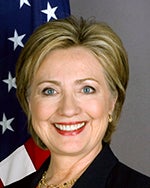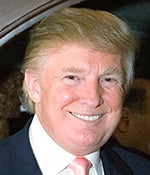GOP hopes late Trump visit will help turn Minnesota red
Published 10:23 am Tuesday, November 8, 2016
MINNEAPOLIS — Republicans hope last-minute visits from Donald Trump and Mike Pence will help propel the state to vote for a GOP presidential candidate for the first time since 1972.
Hillary Clinton was the heavy favorite to capture Minnesota’s 10 electoral votes on Tuesday, but Trump and Pence made separate stops in the state in the final days of the campaign.

Hillary Clinton
Much of the election in Minnesota has focused on three competitive U.S. House races. The campaigns in northeastern Minnesota and suburban Minneapolis have been fueled by millions in outside attack ads.
Democrats and Republicans were also fighting it out in legislative districts across the state as the two parties jostled over House and Senate majorities that will shape the next two years of public policy.
Here’s a look at some of the races on the ballot:
Presidential contest
Neither Clinton nor Trump paid much attention to Minnesota. Clinton dispatched only surrogates as she focused her attention on other Midwestern states, while Trump’s campaign had just one paid staffer on the ground. A Clinton win would extend a Democratic voting streak that began after Richard Nixon swept most of the nation for his second term.

Donald Trump
Congress
Though few expected a competitive presidential race statewide, pockets of Minnesota still felt the burn of hard-hitting politics.
That was evident in northeastern Minnesota’s 8th Congressional District, where Republicans hoped to capitalize on the appeal of Trump’s economic platform in mining towns wracked by a global steel industry downturn. A congressional rematch between Democratic Rep. Rick Nolan and GOP challenger Stewart Mills — who narrowly lost in 2014 — was one of the most expensive races in the country.
The attack ads were also flowing in southern Minnesota’s 2nd Congressional District, an open seat vacated by retiring Rep. John Kline, for a race that was widely regarded as a toss-up. Voters in the southeastern suburbs of Minneapolis were barraged with TV spots featuring controversial comments from conservative former radio host Jason Lewis. Angie Craig aimed to use the GOP candidate’s old career against him to expand Minnesota Democrats’ foothold among the state’s eight congressional districts.
The Trump effect was apparent in the western suburbs, too. It prompted a late campaign from Democratic state Sen. Terri Bonoff. She and outside Democratic groups hoped that the brash businessman’s unpopularity in the area would drag down popular incumbent Republican Rep. Erik Paulsen, who represents the 3rd District.
Legislative majorities
The fight for control of the Minnesota Legislature was being fought in roughly two dozen seats scattered across Minnesota. Republicans were trying to defend a seven-seat House majority they billed as a necessary check against Democratic Gov. Mark Dayton. Meanwhile, Democrats in the Senate were guarding a six-seat edge and several seats in friendly GOP territory.
Other races
Minnesota voters were asked to approve a constitutional amendment to hand power for setting the pay of state representatives and senators to an independent body. Voters also were being asked to return Associate Justice Natalie Hudson to the Minnesota Supreme Court in her first election test since Dayton appointed her last year to fill the seat of retiring Justice Alan Page.
Voters say
Art Meadowcroft, 62, of Plymouth, retired from a career that included work as a college administrator and real estate agent, voted for Trump on Monday. Meadowcroft, a self-described independent, said he admired Trump’s business resume. “Change can be healthy,” he said.
Taryn Kelzer, 41, of Minnetonka, a real estate agent, mother of two and a Democrat, voted for Clinton both because she liked her and because she thinks Trump is too radical, including on immigration. “We are a melting pot. … We need to embrace that and I think his campaign has kind of done the opposite.”





